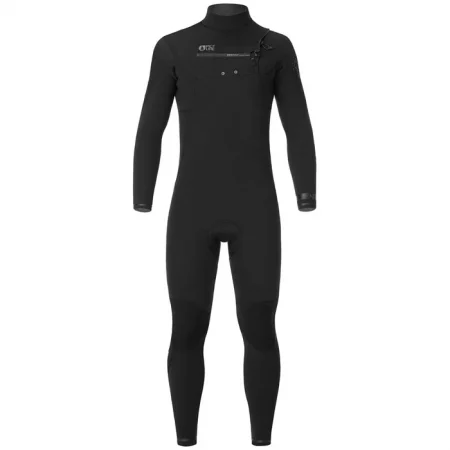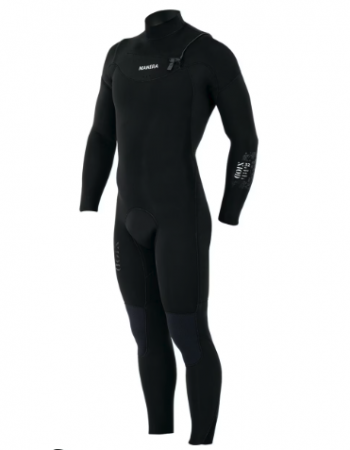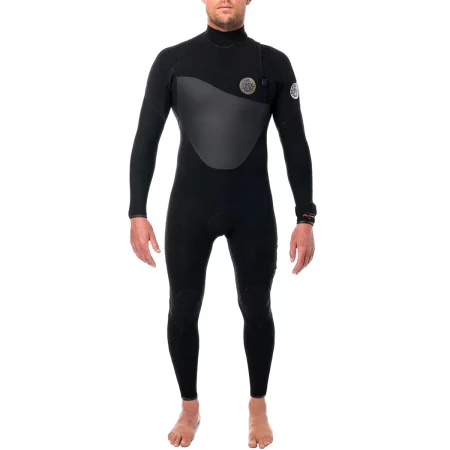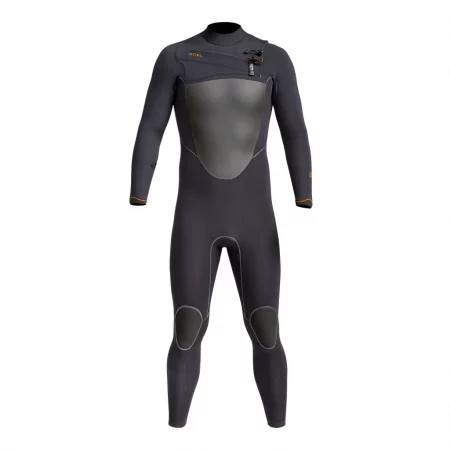
We got our hands on as many wetsuits as we possibly could to put them through the wringer. If you’re looking for the best wetsuit to keep you warm and surfing longer, look no further. Photo: Skyler Fitzmaurice//The Inertia
Wetsuits have come a long way since they replaced the wool sweater in the 1950s and ’60s as an inventive way for surfers to keep warm in cold water. They’ve even come a long way in the past couple of years as new technologies and stretchier, more eco-friendly materials have become a priority for wetsuit manufacturers.
For this review, we asked the top wetsuit brands in the biz to send us their warmest and stretchiest 4/3 wetsuits (no manufacturer paid for placement), and we put them all to the test in the chilly waters of Ocean Beach, San Francisco. Since our first publication of this article in November 2022, we’ve kept this article updated with the latest and greatest wetsuits to hit the market and adjusted our rankings based on continued testing. Included prices are all for the 4/3 (or closest available thickness) unless otherwise noted.
Navigate To: How We Tested | Comparison Table | Buyer’s Guide
Related: The Best Women’s Wetsuits | Best Wetsuit Booties | More Surf Gear Reviews
The Best Wetsuits of 2025
Best Overall Wetsuit: Billabong Furnace Natural Upcycler
Most Comfortable/Runner-Up Best Overall: O’Neill Hyperfreak
Best Value Wetsuit: Picture Equation
Best Budget Wetsuit: Hyperflex Vyrl
Most Durable Wetsuit: Rip Curl Fusion
Most High-Performance Wetsuit: Xcel Comp+
Most Sustainable Wetsuit: Patagonia R-Series
Best Overall Wetsuit
Billabong Furnace Natural Upcycler ($400)
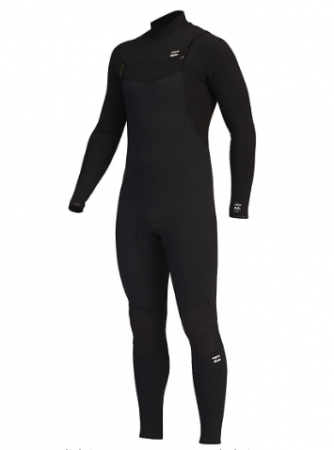
Available In: 3/2mm, 4/3mm, 4/3mm hooded, 5/4 hooded
Construction: Hevea natural rubber neoprene, recycled carbon black from tires and old wetsuits, recycled lining
Features: Key loop in chest zip
Pros: Very eco-friendly, warm, and stretchy wetsuit
Cons: Availability, see editor’s note
Editor’s Note: Unfortunately, due to some behind-the-scenes shake-ups in the surf industry, the Billabong Furnace Natural is extremely hard to get one’s hands on this winter. We’re hearing reports that it should be hitting the shelves again in Spring of 2026, and we will keep this article updated with more information as we get it. For a similarly-awesome neoprene-free wetsuit, we recommend the Patagonia Regulator series.
The Furnace Natural Upcycler from Billabong is an incredible marriage of eco-friendly design, warmth, and performance, and with that, the best wetsuit we’ve tested this year.
Two years ago, for the first edition of The Inertia’s Best Wetsuits, we tested a Furnace Comp from Billabong. And while we were fans of the light, stretchy feel, and great fit, in our first couple of surfs with the suit, we found a number of leaks cropped up, which pushed that suit down the rankings a fair bit. This fall we’ve been testing a Furnace Natural Upcycler, and are pleased to report that after many surfs we have yet to encounter a single leak.
The Furnace Natural is made with natural Hevea rubber, the same material as Yulex, minus the brand name. As far as eco-friendliness goes, it’s right on par with Patagonia’s Regulator series of wetsuits, making use of recycled materials as well for the lining and exterior fabric. In terms of performance, natural rubber has made huge gains in the past year or two, and the Furnace Natural is no exception. The material of this wetsuit feels very light and is just as stretchy as any top-tier suit made with limestone or petroleum neoprene.
We’re also big fans of the exterior jersey, which stretches nicely and has more of a fabric-type feel similar to the Xcel Comp and O’Neill Hyperfreak series of wetsuits. Fit (medium-tall) was spot-on for our lanky tester, and the suit moves very well in the water, with no chafing or pain points. The Furnace is Billabong’s warmth-forward design, and it features a thick, cozy lining from chest to ankles. Those preferring the best in eco-friendly performance at the cost of some warmth would likely be stoked with Billabong’s Revolution Natural wetsuit, which forgoes the thicker lining.
Read our full review of the Billabong Furnace Natural here.
Check Price on CleanLine SurfMost Comfortable/Runner-Up Best Overall Wetsuit
O’Neill Hyperfreak ($420)
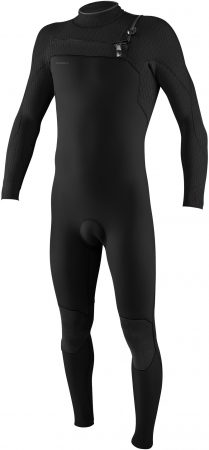
Available In: 3/2+, 4/3+, 4/3+ hooded, 5/4+ hooded
Construction: Limestone neoprene with eco-carbon black and oyster shell powder, recycled seam tape
Features: Key pocket on right calf, TechnoButter neoprene, full seam taping
Pros: Insanely comfortable neoprene and lining, lightweight and moves extremely well, solid price
Cons: Requires proper care to maintain durability
The O’Neill Hyperfreak has been around for ages, only receiving minor updates here and there, and there’s no mistaking why – this wetsuit rocks. The Hyperfreak makes use of O’Neill’s top-of-the-line TechnoButter 3X neoprene, which is easily one of – if not the – most comfortable, stretchy, and lightweight materials in a wetsuit we have ever worn. The suit has full seam-sealing, a great fit (made all the better by the stretchy neoprene), a key pocket, and really everything that you could and should expect in a wetsuit made by one of the top brands in the business.
Of note, the suit only comes in half-thicknesses, 3.5/2.5, 4.5/3.5, etc., which O’Neill describes as 3/2+, 4/3+, etc. For a more traditional-thickness wetsuit, you’ll have to go with the Hyperfreak Comp (3/2, 4/3), which features a slightly slimmed-down design for optimal performance and a zip-free entry. No complaints from us there, however, as the supposed extra .5mm of material was unnoticeable in terms of performance (and honestly in terms of warmth as well). For all intents and purposes, the 4.5/3.5mm suit we tested felt like what you’d expect from a 4/3mm.
The biggest downside to these suits, however, is their durability. Online comments about the Hyperfreak simultaneously praise its insane stretch while lamenting how it doesn’t last as long as some other wetsuits. From our testing, however, we’ve found that the Hyperfreak can last just as long as your average wetsuit – as long as you take proper care of it. The material of the Hyperfreak is a bit more prone to getting stiff and brittle from repeated exposure to salt water. So if you want it to last, make sure to rinse with fresh water after each use, or as often as possible.
We also found the lightweight construction took a bit of a hit to warmth when compared to true “steamer” wetsuits with a thicker lining (like the O’Neill Hyperfreak Fire, below). However, if you’re someone who is willing to take one of the most comfortable and high-performing wetsuits on the market in exchange for a small decrease in durability and warmth, this suit is for you. If those are compromises you aren’t willing to make, it may be worth checking out the O’Neill Hyperfreak Fire, below.
Also of note is the relatively low price point. Compared to other top-of-the-line wetsuits, $390 is pretty dang good. It was a bit of a toss-up between this suit and the Billabong Furnace Natural for Best Overall Wetsuit, but we gave the edge to the Furnace for eco-friendliness and a slight increase in warmth.
Read our full review of the O’Neill Hyperfreak here.
Check Price on CleanLine Surf Check Price on Amazon
Best Value Wetsuit
Picture Equation ($350)
Available In: 4/3mm, 3/2mm
Construction: Limestone, recycled rubber, and oyster shell powder neoprene, recycled interior lining
Features: Rib pads, drain holes on calves, key pocket on right calf, full interior seam taping
Pros: lightweight and flexible wetsuit, with solid warmth for its weight, durable
Cons: Not the warmest construction compared to true “steamer” wetsuits with thicker linings
We’ve known about Picture (formerly Picture Organic Clothing) for a while now, but had no idea they made wetsuits until a couple of years ago. Picture is a company dedicated to sustainability, so we were stoked to see them take a stab at wetsuits, claiming to have an eco-friendly material that beats regular neoprene in terms of stretch.
Picture’s wetsuits are made from a combination of recycled tires, oyster shells, and limestone, with a recycled lining. And they live up to the hype. The neoprene of the Picture Equation felt buttery smooth and quite stretchy, certainly up there with some of the best wetsuits we’ve tried. The lining was comfortable, and it’s got some rad features we’ve never seen in a wetsuit before, like rib pads (a huge boon for skinny surfers without much natural padding in that area) and calf holes to help water drain from the suit. The fit was great, and best of all, despite the sustainable accolades, the suit doesn’t come with the higher price tag most eco-friendly options demand. In fact, the price tag (currently $350 for the 4/3 Equation) was one of the lowest on this list, which is why we gave it the award of Best Value. That’s only made better by the suit’s durability – this suit should last you a few seasons at the very least.
The main downside is warmth, as it’s more of a high-performance suit rather than a steamer suit, which typically features a thicker interior lining. If you want to go the steamer route, I’d recommend checking out Picture’s Dome wetsuits (4/3mm, 5/4mm hooded), which feature similarly competitive prices. For those interested in even more stretch (at the cost of some warmth), check out Picture’s line of Flex Skin wetsuits, which use an even stretchier neoprene in the arms and shoulders.
Check Price on PictureBest Budget Wetsuit
Hyperflex Vyrl ($215)
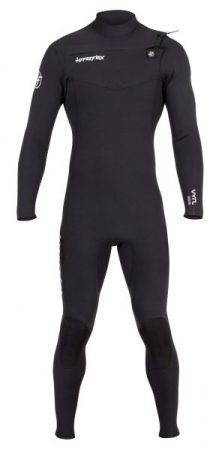
Available In: 3/2, 4/3
Construction: Traditional neoprene, GBS seams, jersey interior lining
Features: Key pocket in chest zip, seam taping at critical points
Pros: Comfortable and stretchy neoprene for a dirt-cheap price
Cons: No cozy interior lining or any bells and whistles to speak of
Good wetsuits don’t come cheap, so when we noticed the $215 price of the Hyperflex Vyrl, we were a bit skeptical. Could a wetsuit that’s less than half the price of many wetsuits on this list stand up to the competition? In short, yes. While the Vyrl is a completely bare-bones wetsuit, with none of the bells and whistles of top-tier suits on this list, it has the building blocks of what makes a great wetsuit, namely, comfortable and stretchy neoprene, solid seams, and a great fit. In testing, we were most impressed with the neoprene quality, which is not far behind the neoprene used in some top-of-the-line suits featured here for flexibility.
The wetsuit lacks features like a warm fuzzy lining and full interior seam-taping, but if you’re shopping for a wetsuit on a budget, chances are these are features you’d be happy to sacrifice to keep an extra couple of hundred bucks in your pocket. Any budget product presents some element of compromise. We feel that it’s certainly better to lose out on a couple of techy features to maintain an otherwise high level of quality than to keep those features and compromise with crappy neoprene or a poorly constructed suit. If the lack of a cozy lining is a sticking point for you, check out the Quiksilver Everyday Sessions, below, which tacks on a warm lining from chest to knees for an extra $45.
Check Price on AmazonMost Durable Wetsuit
Rip Curl Fusion ($540)
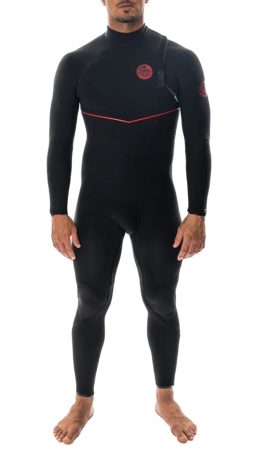
Available In: 3/2, 4/3, 4/3 hooded, 5/4 hooded
Construction: Limestone neoprene, interior and exterior seam taping, Flashbomb lining
Features: Fusion no-stitch seams, zip-free entry, key pocket in chest zip
Pros: Rip Curl’s top-of-the-line suit for warmth and durability with E7 neoprene and a cozy lining from wrists to ankles
Cons: Expensive, no-stitch seams can be a little stiff to begin with
The Fusion is Rip Curl’s top-of-the-line, no-holds-barred suit for warmth and durability. It builds on the success of the Flashbomb Heatseeker, using the same super-stretchy E7 neoprene, Flashbomb lining, and a zip-free entry.
The major upgrade is in the seams. While we found the seams of the Flashbomb Heatseeker to be solid, it seems they weren’t good enough for Rip, as the Fusion makes use of stitch-free seams (they claim to have 96% stitch-free construction) with full seam taping on the interior and exterior of the suit. In testing, we found that the suit was initially not as flexible as we expected due to the double-taped seam construction, but as we wore the suit in more, this issue faded quickly. The Flashbomb lining is one of our favorites, extending from wrists to ankles for added warmth throughout the suit.
The biggest downside is the price, as this suit clocks in at over $100 more than other top-tier suits. Also worth noting, the zip-free entry is noticeably more difficult to put on than a wetsuit that sports a zipper, but there is a definite trade-off in keeping water out, and in a more comfortable paddling experience without a zipper on your chest. It’s also worth noting that there’s no mention of eco-friendly materials used in the production of the suit. Rip Curl does offer a wetsuit recycling program, but it’d be better to start with more sustainable materials in the first place.
All that said, when it comes to what makes a great wetsuit: warmth, stretch, and durability, this is one of the best, truly knocking it out of the park in the warmth and durability departments. Those looking for the ultimate in stretch won’t be disappointed by Rip Curl’s E-Bomb wetsuit, which uses a thinner lining on the inside, and Rip Curl’s E7 neoprene throughout for maximum performance. In comparison to the Xcel Comp+, our favorite high-performance wetsuit, the E-Bomb is a bit warmer and a bit heavier.
Check Price on Cleanline Surf Check Price on Amazon
Best High-Performance Wetsuit
Xcel Comp+ ($400)

Available In: 3/2mm, 4/3mm, 4/3mm hooded, 5/4 hooded, 3mm hooded
Construction: Limestone neoprene, dope-dyed yarn, water-based glue, Eco Carbon Black and oyster shells used in neoprene processing
Features: Key loop in chest zip
Pros: Super stretchy and lightweight suit in a range of thicknesses
Cons: Not super warm
In early fall of 2024, Xcel released a revamped line of wetsuits, featuring updated longstanding favorites like the Drylock and Comp X wetsuits, as well as new suits like the Comp+. The Comp+ has quickly become one of our favorite wetsuits when looking for the ultimate stretch and flexibility, at the cost of some warmth.
The suit features Xcel’s Channel Flex exterior, a super-mobile fabric with tons of stretch and a more fabric-like feel. Xcel describes the suit as “the most comfortable wetsuit we make, with lightweight high stretch,” and we feel that description really nails it on the head. The low-profile lining, stretchy exterior, and top-tier neoprene make for an incredibly lightweight and stretchy wetsuit, and where there’s stretch, comfort is not far behind, with the suit providing some of the most unrestricted movement we’ve found in a 4/3.
The downside? It’s not the warmest wetsuit, even among other performance-oriented options like the Quiksilver Highline, which features a thicker (and cozier) lining. That said, Xcel’s extensive new line of suits includes options like the Comp X, which has a thicker lining through the chest and legs, but the same material and level of stretch in the arms as the Comp+.
It’s also worth noting Xcel’s commitment to be neoprene-free by 2026. While its entire line of suits is currently made with limestone neoprene, the brand says it has something on the cooker in terms of a high-performing neoprene alternative that won’t break the bank, either. Stay tuned for more.
Check Price on Cleanline SurfMost Sustainable Wetsuit
Patagonia R-Series ($509)
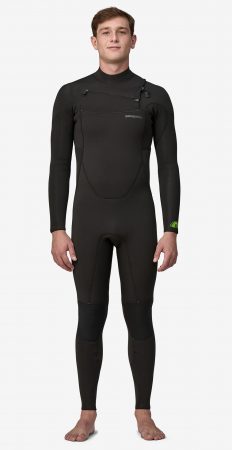
Available In: R1 (3/2.5mm), R2 (3.5/3mm), R3 (4.5/3.5mm), R4 (5.5/4mm hooded), R5 (6.5/5mm hooded)
Construction: Yulex natural rubber, recycled lining, full seam taping
Features: Key loop in front zip, different thickness-rating system
Pros: Eco-friendly Yulex construction that is finally on par with neoprene in terms of stretch and flexibility, new design for better fit and easier repairs
Cons: Fairly expensive, alternative thickness ratings
Patagonia’s Regulator wetsuits are the most sustainable wetsuits you can get your hands on, period. Made from all-natural Yulex material, the impact on the environment is as low as it gets when buying a wetsuit. Also of note is the brand’s repair policy, where they’ll do what they can to keep your suit seaworthy for as long as possible, which, in our mind, ups the sustainability factor considerably, giving Patagonia’s wetsuits an edge over other natural rubber/Yulex wetsuits.
For years, Patagonia wetsuits used to present a fairly large compromise: You’d be helping the environment by choosing a different wetsuit material, but you’d be hurting your performance due to Yulex’s relative stiffness when compared to traditional neoprene. Not so any longer. In the fall of 2023, Patagonia released an all-new line of wetsuits – still called the Regulator, and still sporting the same “alternative” wetsuit thickness/rating system but featuring a radically different construction, and a much stretchier and lighter Yulex material.
While Patagonia has been a bit tight-lipped as to what exactly it’s done differently in these new suits, as wetsuit testers who have experienced both the old and the new Regulator wetsuits, it’s easy to say the difference is night and day. The new suits have stretch that is on par with some of the best traditional and limestone neoprene suits in the business and have proven, so far, to be incredibly durable. And they’re warm, too, with solid seam-sealing (though Patagonia did get rid of the exterior liquid seam-seal from previous generations that added a bit of stiffness), as well as redesigned panels and seam location to improve comfort and make the wetsuits more durable and easy to repair.
For warmth, the recycled lining is quite cozy, but not a standout feature. As far as the alternative thickness ratings go (see above for how that lines up with the R1, R2, R3, etc. designations), while the R2 might get you through a SoCal winter, up north at Ocean Beach, where we did the majority of our testing, the R3 would probably be a better call. Our testers found the fit to be much improved with the new suits, but not quite as comfortable as suits like the Billabong Furnace Natural or O’Neill Hyperfreak. What makes this the most sustainable wetsuit? Well, not only is the wetsuit made of Yulex and recycled materials, similar to our top pick, the Billabong Furnace Natural, but it is also backed by Patagonia’s Ironclad guarantee and was constructed with easy repairs in mind, to keep the suit in the water for as long as possible.
Check Price on PatagoniaMore Top-Tier Wetsuits
While the above represents our top picks, to an extent, we are splitting hairs because there’s a ton of great neoprene out there. Here are some other suits that came oh-so-close to perfection.
Another Overall Runner-Up
Feral Wetsuits ($445)
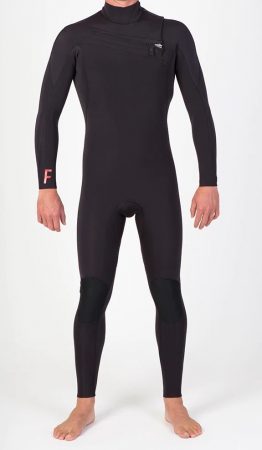
Available In: 3mm2, 4mm3, 3mm+, 543mm
Construction: Limestone neoprene, critical seam-taping, jersey lining
Features: Key pocket on right thigh
Pros: Awesome blend of flexibility and durability, solid price
Cons: Interior lining is a jersey, no fuzzy warmth
When we first released this guide in 2022, the comments section exploded with readers asking us to try Feral wetsuits. So we did, and the wetsuits lived up to the hype. Designed by local Ocean Beach, SF surfers Buzz and Alex, Feral’s goal is to provide surfers like themselves with high-quality, no-BS wetsuits that cut out the marketing gimmicks and focus on what makes a good wetsuit. And they’ve done that, with top-tier Yamamoto limestone neoprene, a solid design made to move with you as you surf, and a fair price that isn’t inflated by marketing budgets or the like. The suit we tried from Feral is the 3mm+ hooded fullsuit, made with 3.5mm of Yamamoto neoprene on the chest and back, and 3mm throughout the rest of the suit.
While not quite as stretchy as some other wetsuits on this list (don’t forget the stretch-durability trade-off), we found the material to be plenty flexible for a full range of motion, with a great fit that had us feeling completely unrestricted both in paddling and while up and riding. The neoprene feels incredibly light, and the seams are (so far) bomber with interior seam tape used in critical locations of the suit. The biggest downside we found was the lack of a fuzzy interior lining, but for a no-bs, everything you need and nothing you don’t wetsuit, you’ll be hard-pressed to find an equal to Feral.
Check Price on Feral SurfingSuper Warm Steamer
O’Neill Hyperfreak Fire ($450)
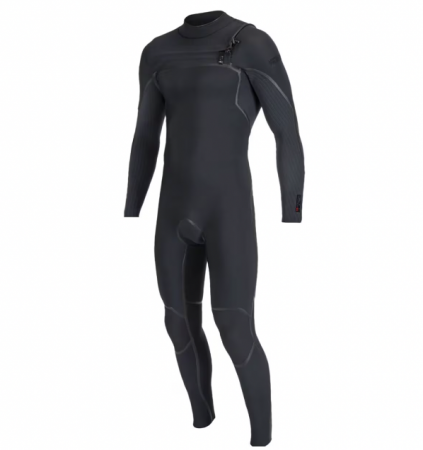
Available In: 4/3+, 3/2+
Construction: Limestone neoprene, recycled lining, oyster shells/eco carbon black used in neoprene production
Features: Extra .5mm of neoprene, key pocket on right calf, TB4 lining, full interior seam-taping and exterior liquid seam-seal
Pros: Super warm while retaining a high level of stretch and flexibility
Cons: Not available with a hood
The O’Neill Hyperfreak Fire debuted last winter, elevating the popular Hyperfreak with a new TechnoButter 4 lining designed for increased warmth, as well as liquid seam sealing on the outside of the suit. The neoprene on this suit is awesome – while it isn’t quite as stretchy as the Hyperfreak above, thanks to the added interior lining, what you get in return is steamer-level warmth without the weight and stiffness that some thicker linings have, and an upgrade in durability.
Similar to the Hyperfreak, the Hyperfreak Fire only comes in half thicknesses: instead of a 4/3, O’Neill presents us with a “4/3+” which has an extra half millimeter of neoprene, making it a 4.5/3.5. The suit is also available in 3/2+. In comparison to the Hyperfreak above, the additional thickness is a bit more noticeable here, since a thicker lining is being tacked on as well. That makes the suit insanely warm, so for those who run cold and like a bit of extra rubber, this suit is a winner.
However, we did find that the suit is not available in a hooded version, a definite con for cold-water warriors. Another very small, very nit-picky “con” was the lower-leg key pocket. It’s a bit too small to fit an electric key fob in a slim waterproof case, not a problem on other suits with the lower-leg pocket.
Check Price on CleanLine Surf Check Price on Amazon
Runner-Up Best Budget
Quiksilver Everyday Sessions ($270)
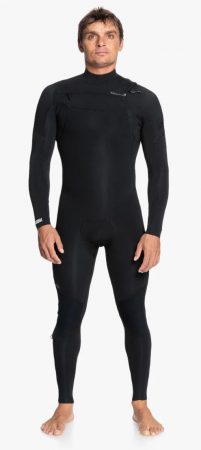
Available In: 3/2, 4/3, 5/4/3
Construction: Limestone neoprene, recycled lining, critical seam taping
Features: interior lining from chest to knees, back and front-zip varieties
Pros: Cozy lining, comfortable neoprene, great price
Cons: Tough to find in a chest-zip construction at the time of publishing
When determining the Best Budget Wetsuit for this review, we were torn between Quiksilver’s Everyday Sessions wetsuit and the Hyperflex Vyrl, above. Where the Vyrl wins out on price, the Everyday Sessions wins out on comfort with a cozy interior lining from chest to knees, and better seam-sealing with more interior taping in critical areas. Up to you which makes the most sense for your wallet.
The suit uses Quik’s StretchFlight Neoprene, which our testers have found to be on par with the best in the biz in terms of stretch, flexibility, and lightness. Of note, the most availability we found for this wetsuit was in the back-zip variety, so if you prefer a chest-zip, as has become the norm these days, you might have some trouble finding your size.
Check Price on AmazonSuper Light, Great Fit
Manera X10D ($470)
Available In: 3/2mm, 4/3mm, 4/3mm hooded, 5/4/3mm
Construction: Limestone neoprene, full seam taping, dope-dyed yarn
Features: Super light neoprene, 3D construction
Pros: Super light and great-fitting wetsuit, highly durable
Cons: Expensive, no key loop or pocket
For the past few years, we’ve been massive fans of the French-made Manera wetsuits. For those who aren’t familiar, Manera’s claim to fame is the “3D design” of its suits, which the brand says fits the shape of the human body better than suits designed in 2D, and we find it hard to disagree. These wetsuits fit exceedingly well, and the X10D suit packs a punch when it comes to performance, featuring extremely lightweight neoprene and great flexibility.
The stretch is solid, not quite as stretchy as other top-tier suits on this list, but it comes darn close. Where this suit truly shines is the lightness of the neoprene. Performance-wise, the suit feels like a 3/2, while retaining the warmth of a high-performance 4/3. And the weight reflects that as it’s a full half-pound less than some of the steamers. If the wetsuit were slightly cheaper or a bit stretchier, this would have been our top-pick high-performance wetsuit.
That said, one area where Manera’s wetsuits shine is durability. These wetsuits stand the test of time, especially in the seams. Though based on current testing, we’ve got to give a slight edge on durability to the Rip Curl Fusion, above. Our one complaint is the lack of a key loop or pocket, but we’ve heard this feature will be rolled out soon across Manera’s entire line of suits.
Check Price on Cleanline SurfSolid Value Steamer
Volcom Modulator ($315)
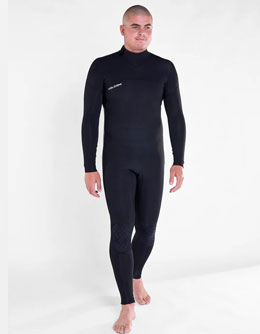
Available In: 2/2, 3/2 (chest-zip and back-zip), 4/3 (chest-zip and back-zip), 4/3 hooded, 5/4/3 hooded
Construction: Limestone neoprene, water-based glue, Eco Carbon Black and oyster shell powder used in neoprene production
Features: Key loop in chest zip
Pros: Great value for a warm steamer-level wetsuit, available with a hood
Cons: Lacks a premium feel and a bit of stretch compared to top picks
Volcom’s Modulator wetsuit packs a punch at just $315, with a warm lining, solid fit and construction, and premium design elements such as fully taped GBS seams and a plush lining.
Compared to another value-priced wetsuit, the Picture Equation, the Modulator features a thicker lining from chest to knees, and a jersey material in the arms and below the knees, while the Equation has a thinner fleece from wrists to ankles. The Equation is a bit more flexible throughout as a result, while the Modulator keeps a bit better core warmth. The Modulator is offered with a hood, whereas the Equation is not.
Check Price on REAL Watersports Check Price on Amazon
Awesome Blend of Warmth and Stretch
Rip Curl E7 Flashbomb ($420)
Available In: 4/3mm, 3/2mm, 5/4 hooded
Construction: Limestone neoprene, full Flashbomb lining, full seam taping
Features: Zip-free entry, key pocket on left calf
Pros: Warm wetsuit with super stretchy neoprene and less bulk than traditional steamer suits
Cons: No mention of sustainable elements used in construction, in between steamer and high-performance
Rip Curl’s Flashbomb has been around the block for a while, and there are no surprises as to why. If it ain’t broke, why fix it? Pulling this suit on for the first time is an experience in luxury, with a super-cozy fleece lining throughout the entire suit, and wildly stretchy E7 neoprene from Rip Curl.
The fit is surprisingly good – laid flat, the suit looked somewhat boxy (which usually doesn’t bode well for our tester’s lanky frame), but it fit him like a glove thanks to the wetsuit’s super stretch. This wetsuit is a crossover steamer/high-performance suit, with steamer-level warmth and the stretch (but not quite the lightness) of a high-performance suit. Also of note is the zip-free entry, which is notoriously difficult to get on but does a great job of sealing out water. This year, Rip Curl’s entire wetsuit line has been revamped somewhat, and this wetsuit is now offered in chest zip as well as no-zip varieties if the no-zip entry is not something you’re stoked on.
The suit also comes in a couple of different constructions/materials, notably the Heatseeker Flashbomb, which has heat-generating material in the back and shoulders for an extra $100.
Check Price on CleanLine Surf Check Price on Amazon
Great Value High-Performance Wetsuit
Quiksilver Highline ($360)
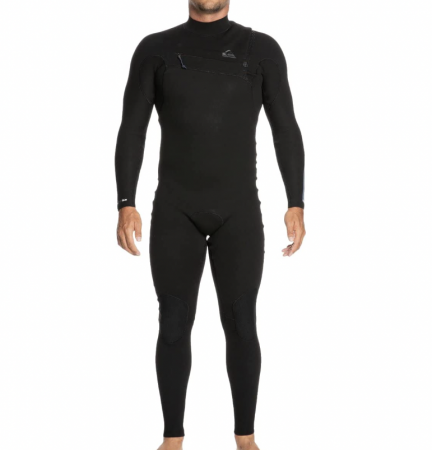
Available In: 3/2mm, 4/3mm, 5/4/3mm
Construction: Dope-dyed interior, limestone neoprene, full seam taping
Features: Super light and stretchy neoprene, key loop in front zip
Pros: Great value for a super high-performing and toasty warm wetsuit
Cons: Fit could be better (though that’s helped by stretchy neoprene)
Quiksilver blew us away with the Highline. A performance-based wetsuit with a solid, warm lining, Quiksilver’s neoprene is top-tier in terms of stretch, with an exceedingly comfortable and fairly lightweight lining from wrists to ankles. It wasn’t quite as warm as wetsuits with a dedicated steamer-thickness lining, but overall, the suit is far lighter and more mobile than your average steamer, fits quite well, and has a great price, to boot. As things stand, this is one of the best wetsuits we’ve experienced for high-performance stretch with a bit of extra warmth.
Durability-wise, we’re very impressed with how this wetsuit has stood up over time, especially since high-performance, stretch-oriented suits tend to wear out the fastest. While it’s not quite as mobile as the Xcel Comp+, there is a definite increase in warmth, though not as much as a steamer. The fit wasn’t the absolute best in the neck/chest area for our lanky tester, but this fact was helped a lot by the stretchy neoprene. If what you are looking for is a high-performance suit that doesn’t compromise (too much) on warmth, and makes you forget you’re wearing a 4/3, the Quiksilver Highline is a great choice.
Check Price on CleanLine SurfHigh-Tech Steamer
Xcel Drylock ($520)
Available In: 3/2mm, 4/3mm, 4/3 hooded, 5/4mm hooded, 6/5 hooded
Construction: Limestone neoprene, full seam taping, TDI lining from chest to knees
Features: Key loop in chest zip, gusseted wrist cuffs to prevent flushing, full seam taping, windproof smoothie panel on chest, back, and hood (for hooded versions)
Pros: Super warm and easy-moving wetsuit with plenty of thickness/style options (hood/no hood)
Cons: A little pricey
We’ve been wearing Xcel wetsuits for a while, and they still impress as much as ever. The Drylock features some insane warmth-generating tech on the inside, such as the Celliant Black lining that’s said to generate extra heat, as well as stretchy material in the arms and shoulders for paddle-ability. Our lanky tester found the fit on a straight medium to be a little off, with the arms especially feeling too short for his longer limbs, but there are plenty of size options to help you dial in that perfect fit.
Warmth is where this suit shines. In testing, this suit is noticeably warmer than much of the competition, and without the bulkier linings sported by some steamer suits. However, the price is fairly high compared to other wetsuits in this review, and our tester didn’t find it to be the most durable either, with some seam leakage after regular use. Overall, this suit is an awesome steamer suit with impressive stretch and paddle-ability, though our few nitpicks kept it away from earning that top spot.
Check Price on XCEL Wetsuits Check Price on Amazon
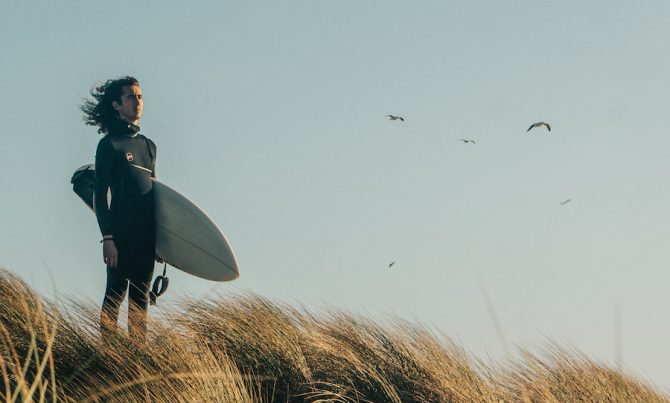
The Dakine Cyclone is one of the most durable wetsuits we’ve tested. Photo: Skyler Fitzmaurice//The Inertia
Honorable Mentions
There are a ton of incredible wetsuits out there on the market. And with only so much room on the proverbial page before boring you, or worse, overwhelming you with options, dear reader, we had to include only the best of the best wetsuits here. These honorable mentions are the ones that came oh-so-close to making the cut.
Two years ago, we got to try out the Dakine Cyclone. And to our surprise, after truly putting this suit through the wringer during that time period, the seams continue to stay fairly bomber with a few pin-pricks of water here and there. With that in mind, we’ve gotta give them props for creating an awesome wetsuit that stood up to a ton of hard use. The neoprene has lost a bit of the new-suit stretch, but it still feels great once you hit the water, and it looks like the current lineup from Dakine has an even warmer lining. We’re stoked to get our hands on the latest suits and add them to this review when we do so.
One of the latest suits to hit the market this fall is the Vissla New Seas, featuring a rare entry system, the U-zip. Engineered to provide an easy entry, while also sealing out water much better than your average chest zip, we’ll be stoked to add this wetsuit to the review and provide you with our feedback on the alternative design once we’re able to get our hands on one for testing.
If you’re looking for a solid, durable, steamer-worthy budget wetsuit, the Rip Curl Dawn Patrol is a worthy contender at $280. The suit’s construction is a step up over most other suits in the price range, with interior seam tape throughout, except for the arms, for better paddle-ability. It also has a cozy Flashbomb lining from chest to knees. However, we found the E5 neoprene to be noticeably less stretchy than the E7 used in Rip Curl’s top-tier suits, not quite as stretchy as the Quiksilver Everyday Sessions, above, and about as stretchy as the Hyperflex Vyrl. That said, for warmth and durability at a solid price, this suit delivers.
Another option we’ve been testing this summer is the Finisterre Nieuwland series. Made from Yulex natural rubber and recycled materials, these suits are as good as it gets when it comes to eco-friendliness. The brand even offers a repair program (within the UK) and has excellent customer service to boot. Among other services that the brand offers is a customized wetsuit build program for those with specialist needs and a wetsuit rental program with financial support options, all aimed at expanding access to the ocean.
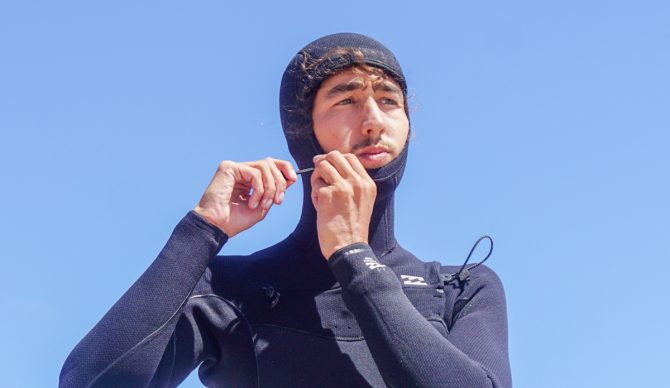
In testing the 4/3 hooded version of the Furnace Natural in Northern California, we were very impressed with the comfort that the hood provides. Photo: Quincy Sileo//The Inertia
Best Wetsuits Comparison Table
| Suit | Price | Key Pocket | Style | Construction |
| Billabong Furnace Natural | $400 | Front zip | Steamer | Natural rubber, recycled lining, full seam taping |
| O’Neill Hyperfreak | $420 | Lower leg | High-performance | Limestone neoprene with eco-carbon black and oyster shell powder, full seam taping |
| Picture Equation | $350 | Lower leg | Performance/crossover | Limestone, recycled rubber, and oyster shell powder neoprene, recycled interior lining, full seam taping |
| Hyperflex Vyrl | $215 | Front zip | Neutral | Traditional neoprene, GBS seams, jersey interior lining, critical seam taping |
| Rip Curl Fusion | $540 | Front no-zip | Crossover | Limestone neoprene, interior and exterior full seam taping, Flashbomb lining |
| Xcel Comp+ | $400 | Front zip | High-performance | Limestone neoprene made with Eco Carbon Black and oyster shells, dope-dyed yarn, full seam taping |
| Patagonia R-Series | $509 | Front zip | Neutral/crossover | Yulex natural rubber, recycled thermal lining, full seam taping |
| Feral Wetsuits | $445 | Upper leg | Neutral | Limestone neoprene, critical seam-taping, jersey lining |
| O’Neill Hyperfreak Fire | $450 | Lower leg | Crossover/steamer | Limestone neoprene with oyster shells/eco carbon black, recycled TB4 lining, full seam taping |
| Quiksilver Everyday Sessions |
$270 | Front/back zip | Neutral | Limestone neoprene, recycled lining, critical seam taping |
| Manera X10D | $470 | None | High-performance | Limestone neoprene, dope-dyed yarn, full seam taping |
| Volcom Modulator | $315 | Front zip | Steamer | Limestone neoprene with Eco Carbon Black and oyster shell powder, full seam taping |
| Rip Curl Flashbomb | $420 | Lower leg | Crossover | Limestone neoprene, Flashbomb lining, full seam taping |
| Quiksilver Highline | $360 | Front zip | High-performance | Dope-dyed interior, limestone neoprene, full seam taping |
| Xcel Drylock | $520 | Front zip | Crossover/steamer | Limestone neoprene, full seam taping, TDI lining from chest to knees |
What Matters Most When Buying a Wetsuit? How Did We Calculate Recommendations for Best Wetsuits?
Our criteria for this review were the building blocks of what makes a good wetsuit: warmth, stretch, and durability. We’ve made sure to speak to each of these aspects of good wetsuit design in our review for each suit, and used these as our main criteria in determining our winner.
Since durability is a bit harder to capture in back-to-back testing, that criterion was weighted less than warmth and stretch, the two main considerations. Scroll to the bottom for more info on these criteria, as well as other things that matter in buying a wetsuit.

These wetsuits weren’t going to test themselves, so we put them through their paces at Ocean Beach, in San Francisco, an excellent wetsuit proving ground. Photo: Skyler Fitzmaurice//The Inertia
How We Tested The Best Wetsuits
Our lead tester for this review is Will Sileo, a Bay Area native and cold-water surf aficionado. For consistency, he did his best to only test 4/3 front-zip suits. However, the wetsuits tended to fall into two main categories: true “steamer” wetsuits, which prioritized warmth, and more “high performance” suits that prioritized light weight and stretch. He’s done his best to indicate which way each suit leans.
We weighed the possibility of running different warmth and stretch tests, subjecting ourselves to cold plunges with the suits on or stretching them as far as they go before they rip in half, but we quickly realized the cold plunge would be extremely challenging to do accurately. How long would it take between tests to recalibrate one’s body heat? An ultimate stretch test didn’t (at least to us) seem indicative of what a wetsuit actually goes through during use.
So we did what any surfer would do. We surfed in these wetsuits as much as possible over the past couple of years, often going through multiple suits a session for accurate comparisons. We also compiled helpful data like wetsuit weight and additional features to provide as full a picture as possible to help you make the best decision when purchasing your new wetsuit.
While that may seem like the best job in the world (and, we admit, it’s pretty fun), we assure you there is nothing glamorous about getting out of the water when the waves are firing to jog back to the car, take off a wet wetsuit, yank a dry one on over a still-wet body, and get back in the water. All for you, dear reader.
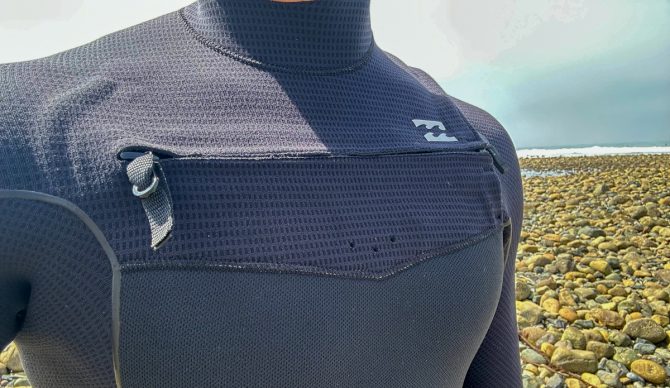
Testing the Billabong Furnace Natural at Trestles this spring. Photo: Zach Weisberg//The Inertia
Recent Updates
This article was first published in November of 2022, and since then has received an early fall and mid-winter update each year to reflect our continued testing and bring the latest and greatest wetsuits into the fold. Due to testing constraints, this review started with mostly big-name wetsuit brands, but in the past two years, we have worked to include the most promising smaller wetsuit brands and would consider this to be the most accurate picture of the wetsuit industry currently on the internet.
In our most recent update in August of 2025, we added some additional information to the buyer’s guide, added a wetsuit to our honorable mentions based on recent testing, and made sure all of our links were in order. Thanks for reading.
Editor’s Note: For women, check out our guide to The Best Women’s Wetsuits. And here are our guides to The Best Wetsuit Booties and the Best Wetsuit Gloves. Surfing somewhere warmer? Check out our guide to The Best Springsuits for Surfing, or The Best Boardshorts. For more surf gear reviews, click here.

When it comes to wetsuit fit, Manera’s X10D is second to none. Photo: Skyler Fitzmaurice//The Inertia
Best Wetsuits Buyer’s Guide
Different Wetsuit Styles
All wetsuits perform a delicate balancing act between warmth and performance. On one end of the spectrum, you’ve got high-performance suits built for stretch and flexibility — the ones that make you forget that you’re wearing a wetsuit in the first place, but aren’t quite as toasty warm on the coldest of days.
On the other end are warmth-oriented “steamers,” designed with thicker neoprene and more insulation. These wetsuits really lock in the heat, but every millimeter of neoprene, as well as those thicker cozy linings, adds resistance and makes movement just a little stiffer.
Most wetsuits live somewhere in between these two extremes, but some options lean strongly in one direction or the other. For example, the O’Neill Hyperfreak Fire, while it does use O’Neill’s stretchiest neoprene, has a thicker interior lining than, for example, the more performance-oriented Hyperfreak series.
Finally, budget wetsuits are a category in and of themselves, doing away with cozy linings and the stretchiest materials to make a smaller dent in your bank account. That’s not to say they are bad wetsuits, as there are plenty of budget suits (like the Hyperflex Vyrl series included here) which cover the basics of warmth and flexibility while keeping costs relatively low. Just don’t expect to have a cozy, warm lining or the best and stretchiest neoprene on the market.
Wetsuit Fit
Without a doubt, fit is the most important factor in choosing a suit. It doesn’t matter if it’s the stretchiest and warmest suit in the world; if the fit isn’t right, you will not enjoy wearing it.
All of the suits tested in this review are a size MT or M, which are generally our tester’s preferred wetsuit sizes at 6’0” and 150-ish lbs, depending on the suit itself. As you can probably tell from the photos, our lead tester is a bit of a lanky guy, usually leaving him with a bit of exposed skin at the wrists and ankles in a classic medium, which is why he usually prefers an MT. In this review, he’s made sure to point out when a suit fits particularly badly or particularly well.
However, fit is as personal as it gets. Be sure to read the size charts, and if you find a manufacturer whose suits fit you particularly well, it might be worth sticking to your guns.

The O’Neill Hyperfreak Fire clocks in as a super-warm and high-performing suit, with O’Neill’s new TechnoButter4 neoprene and lining. Photo: Skyler Fitzmaurice//The Inertia
Warmth vs. Stretch
The second and third most important factors in choosing a suit. While these two criteria certainly aren’t mutually exclusive, they do cut against each other. Want a warmer suit? That means more layers of insulation (both in terms of the millimeters of neoprene itself and a heftier lining of the inside of the wetsuit) and less flexibility. Want more stretch? Gotta make a sacrifice somewhere.
For example, look at the O’Neill Hyperfreak and O’Neill Hyperfreak Fire. The Fire tacks on a thicker lining over the Hyperfreak, providing better warmth, but the classic Hyperfreak wins out on mobility. Some wetsuits on this list prioritize stretch, some prioritize warmth, and others try to strike a happy medium. It’s certainly worth taking a sec to figure out your priorities before going all-in on new rubber.

The Vissla North Seas is a great choice for a very warm wetsuit that won’t break the bank, and is easy on the environment, to boot. Photo: Cory Diamond//The Inertia
Sustainable Wetsuits
Eco-friendly manufacturing is booming in the surf industry, and wetsuits are no exception. It used to be that if you wanted an eco-friendly wetsuit, your option was Patagonia, and while Yulex/natural rubber is still the most sustainable wetsuit out there due to Patagonia’s commitment to repairs, it’s no longer the only one made from natural rubber. For their part, Patagonia has proactively shared the technology with other manufacturers for the sake of the planet. It’s also not a bad marketing talking point for Patagonia.
As far as other wetsuit materials go, regular neoprene is derived from crude oil, which makes it very environmentally unfriendly indeed, putting it at the bottom of the list. Not far above that sits limestone neoprene (also referred to as Yamamoto neoprene), which uses calcium carbonate from limestone instead of crude oil. That’s certainly better as a step away from fossil fuels, but limestone still needs to be extracted from the earth and takes a lot of energy to transform into the chloroprene chips that are then turned into neoprene.
Even better than limestone are wetsuits produced with recycled materials such as rubber from old tires (like Quiksilver and others’ “Carbon Black”), oyster shells, and other recycled materials. Many brands on this list use a mixture of limestone and recycled materials to make their suits, which is a good start, but not as sustainable as Yulex.

The Picture Equation lands solid eco-friendliness at an incredible price, with a cozy lining, stretchy neoprene, and fun features. Photo: Skyler Fitzmaurice//The Inertia
Performance-wise, limestone neoprene probably performs the best, with regular neoprene clocking in at a super-close second-best. Limestone neoprene can sometimes be a little less stretchy than regular neoprene, but it is, in all cases, super flexible (not stiff at all), and that lack of stretch adds to the durability. Recycled blends vary, but are often majority limestone, and therefore quite high-performing. Yulex used to be the lowest-performing material here, but new tech and different blends have closed the gap in recent years.
The most recent line of Patagonia Regulator wetsuits, in fact, has proven that Yulex has the potential to reach the same level of performance as traditional and limestone neoprene. Billabong, as well as a few other manufacturers, quickly followed suit, and this year’s Billabong Furance Natural has proven to us that there is no longer any difference in performance with natural rubber – neoprene-free is no longer lower performing, and we awarded that leap forward with the Best Overall Wetsuit designation.
There are a few additional sustainability efforts of note from wetsuit manufacturers. The use of recycled polyester or nylon in the lining of the suit, water-based glue (such as Aqua Alpha) for seam sealing, and dope-dyed fabric all contribute toward minimizing the footprint of a wetsuit. Another notable sustainability effort is Patagonia’s Ironclad Guarantee, where they’ll keep repairing your wetsuit for years to come.
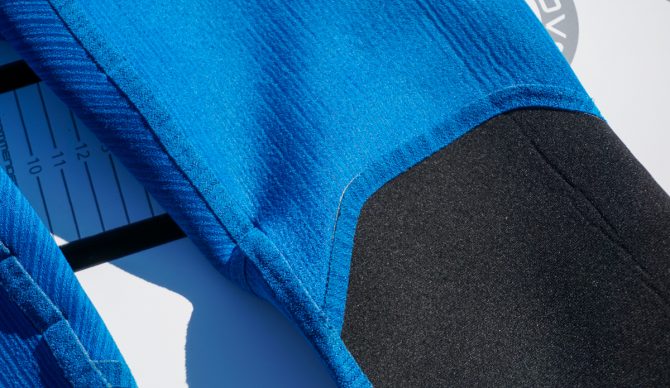
Fully taped seams (pictured here: the O’Neill Hyperfreak) help prevent water from getting in, adding to a wetsuit’s long-term durability. Photo: Will Sileo//The Inertia
Wetsuit Durability
All that being said, perhaps the most important aspect of an eco-friendly wetsuit is its durability. The longer a wetsuit lasts before you have to buy a new one, the less of an impact your years of wetsuit-buying will have in the long run. And it will save you money, too. Overall, stretchier suits tend to degrade faster, and while Yulex suits don’t win the stretch category, they do win the durability category for that reason. We will keep this article updated with notes on durability as we continue surfing in these suits.

Some zippers require two hands (Billabong), some don’t, but then need a snap to make sure they stay shut (Quiksilver). Photo: Skyler Fitzmaurice//The Inertia
What Other Features Matter in a Wetsuit?
There are plenty of other factors to consider when buying a suit. Perhaps the most impactful is the key pocket. We generally prefer a key loop inside the front zipper as it can accommodate both a car’s small valet key or a larger fob in a waterproof case.
Another popular design is the outer calf key pocket, which is way more comfortable, but maybe a little less secure and a far smaller pouch area than the front zip of your suit, which can be troublesome for larger keys. However, the KGuard electronic key bag with a fob inside managed to fit in all of the calf pockets we tested, except for O’Neill’s. A larger pouch, like the Aquapac Keymaster, would not have fit in any of the calf-pockets we tested.

A good key pocket in your suit is a must these days. Photo: Skyler Fitzmaurice//The Inertia
Zipper design is another feature of note. Some zippers require that you put the two pieces of the zipper together, while others have the zipper already attached, allowing you to simply pull it across one-handed. However, most of these suits then require a snap to keep the zipper from opening. The first is more secure, but a bit more troublesome than the second option.
Seams matter, too. GBS seams (Glued and Blind Stitched) are the best in terms of water permeability, which all of the wetsuits in this review have. Most of the suits also make use of inside taping, and some even go for seam seals on the outside. The Rip Curl Fusion forgoes stitching in its seams in favor of durable seam tape on the exterior and interior of the suit. Both taping and seam seals increase the waterproofing and longevity of a suit, but can reduce the overall flex.

A liquid seam seal on the outside of a wetsuit will keep your seams watertight for a lot longer than normal. Photo: Skyler Fitzmaurice//The Inertia
How Do I Take Care of My Wetsuit?
Choosing the right rubber is important, but so is treating your wetsuit well to ensure it will last you as long as possible. After each use, make sure to rinse your wetsuit with fresh water and hang it to dry (check out our guide to the best wetsuit hangers) in the shade. Reminder: Fold your suit to hang it. Don’t hang it by the shoulders. This will help you avoid gravity stretching (and eventually) tearing those shoulders over time.
Sun and salt water, especially in combination, will reduce your wetsuit’s overall lifespan. They’ll also make the rubber stiffer and less flexible. If you notice that happening, you can always use one of these awesome wetsuit washes, which will also help kick the wetsuit stink before (or even after) it starts.
We do our best to wash our wetsuits with a cleaner every couple of weeks to keep them feeling supple and smelling good. If you happen to rip your wetsuit or notice your seams are letting in more water than you would like, don’t worry, your wetsuit’s life is far from over. Check out our helpful guide to wetsuit repair.

The seams on the Rip Curl Fusion wetsuit are stitch-free, and claim to be leak-free, too. Photo: Skyler Fitzmaurice//The Inertia
How Long Should My Wetsuit Last?
Your wetsuit should last at least a year for the every-damn-day surfer and potentially a lot longer than that if you surf less (and are a fully grown adult). We have wetsuits that have held up well to regular use for up to three years, basically the gold standard of durability. But a wetsuit is expensive. It should last. Less-stretchy, more durable wetsuits will last longer than high-performance, high-stretch wetsuits.
You can keep your suit seaworthy even longer by re-sealing your wetsuit seams when they start to fail, washing your wetsuit after each session with fresh water, regularly applying a wetsuit wash, being gentle when taking your wetsuit on and off, and generally avoiding the downward spiral of negligent wetsuit care. Don’t change directly on asphalt (especially parking-lot asphalt with all that yucky car grease) or let your wetsuit sit in its own funk overnight because you were too lazy to wash it after your evening session. All those sorts of actions contribute to wetsuit deterioration.

Wetsuits with an attached hood add a significant amount of warmth to the equation. Photo: Skyler Fitzmaurice//The Inertia
What Thickness Wetsuit Should I Get?
Great question, and one that depends on a variety of factors, including where you surf, what time of year you’re surfing, and how hot/cold you tend to run. In Northern California, where we did the majority of our testing, a 4/3 wetsuit is the go-to, year-round suit, but dedicated winter surfers or those who run cold might choose a 4.5/3.5, 5/4/3, or 5/4.
A hood is often a great idea, too, to ward off that brain freeze. Down in Southern California, a 3/2 is often the suit of choice, with all but the hardiest of surfers switching over to a 4/3 come fall/winter. Below is a general guide to choosing wetsuit thickness based on water temperature, based on Quiksilver’s temperature chart.
| Water Temperature | Wetsuit Thickness | Other Accessories |
| 75+ | Boardshorts/Rashguard | Wetsuit jacket if you run cold |
| 65-75 | .5-2mm wetsuit jacket/springsuit | N/A |
| 60-65 | 3/2mm fullsuit | N/A |
| 55-60 | 4/3mm fullsuit | booties and hood if you run cold |
| 50-55 | 5/4mm fullsuit with hood | booties, gloves if you run cold |
| 50 and below | 6/5mm fullsuit with hood | thick booties and thick gloves |
However, the above is just a guideline. There are a lot of other factors to consider when choosing a suit. First is personal cold tolerance. While a thinner suit will tire you out less and overall allow for faster reactions, all those advantages go away when your body is tense or even shivering with cold.
Wind and sun can also play a big role. Surfers in windier conditions would benefit from a rubber “smoothie” panel, which some wetsuits, like the Xcel Drylock, have on the chest and/or front that helps block windchill. And if it’s overcast, not only will the sun not be warming you, it won’t be warming the top layer of the water those crucial few degrees either.

Feral wetsuits feature minimal branding for the all-black surfer aesthetic. Photo: Skyler Fitzmaurice//The Inertia
Another consideration is how active you tend to be in the water. Surfers who are constantly paddling can choose a thinner suit like the Xcel Comp+, and those who find themselves sitting and waiting for waves would probably prefer a thicker suit. This can also vary from one break to the next, depending on crowd factor, the type of wave, and other factors.
When we’re surfing Pleasure Point, in Santa Cruz, for example, we tend to choose a thicker suit as we wait our turn amongst the crowd. At Ocean Beach, a thinner suit can help keep one’s arms fresh as you battle the lines of whitewater to reach the outside. However, you’ll likely want to choose a suit with a hood for such a break to combat brain freeze from the constant duck-diving.
If you’ve made it this far, thanks for reading. We’ll be doing our best to keep this article updated as wetsuits go in and out of stock online. We will also keep you posted as we’re able to try any new wetsuits or if any durability problems arise that were premature to note here.
Return to Top Picks | Return to Comparison Table
Editor’s Note: Check out our full collection of surf gear reviews. For other gear reviews and features on The Inertia, click here.

